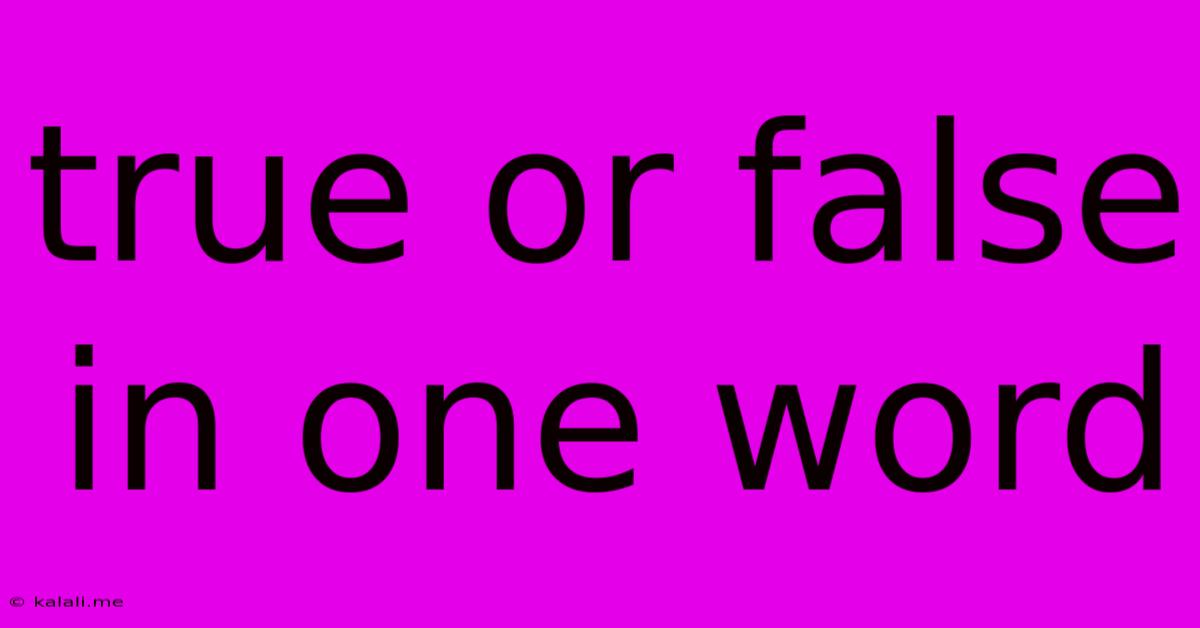True Or False In One Word
Kalali
Jun 01, 2025 · 3 min read

Table of Contents
True or False: One Word Answers and Their SEO Implications
This article delves into the seemingly simple act of answering with "true" or "false," exploring its nuances, applications, and surprising SEO implications. While a single word answer might seem insignificant, its context and strategic use can significantly impact online visibility and reader engagement. This is especially relevant for websites that frequently utilize quizzes, tests, or fact-checking content.
What Makes "True" or "False" Unique in the Digital Landscape?
The binary nature of "true" or "false" is inherently concise and efficient. This simplicity makes it ideal for various online applications, including:
- Quizzes and Assessments: These are immensely popular online, driving traffic and engagement. The immediate "true" or "false" feedback enhances the user experience.
- Fact-Checking Websites: These sites rely on quick, definitive answers to establish credibility and authority. A clear "true" or "false" is crucial for this.
- Educational Resources: Interactive learning often incorporates true/false questions to test comprehension.
- Data Validation: Behind the scenes, many online systems use true/false logic for data processing and decision-making.
SEO Considerations for One-Word Answers:
While seemingly simple, effectively integrating "true" or "false" answers into your content strategy requires careful consideration of SEO best practices:
- Context is King: Simply sprinkling "true" and "false" throughout your content won't boost SEO. These words must be embedded within relevant and engaging content. For example, a blog post about historical facts should naturally incorporate true/false statements within the body.
- Keyword Integration: While "true" and "false" themselves are not high-volume keywords, the topic around which you use them should incorporate relevant keywords. If discussing historical facts about the American Revolution, integrate keywords like "American Revolution," "Revolutionary War," "colonial America," etc.
- User Experience: The goal is not just to rank highly but also to provide a valuable user experience. Ensure your true/false statements contribute to the overall understanding and engagement of the reader. Avoid overly simplistic or trivial questions.
- Schema Markup: Consider using schema markup to specify the "True/False" nature of your content. This helps search engines understand the structure and context of your data, potentially leading to richer snippets in search results.
- Content Variety: Don't solely rely on true/false questions. Diversify your content with other question formats like multiple-choice or open-ended questions to maintain reader interest and avoid appearing monotonous.
Optimizing Content with True/False Statements:
To maximize the SEO potential of true/false questions, follow these guidelines:
- Create High-Quality Content: Ensure your content is well-written, informative, and provides value to the reader beyond just the true/false answers.
- Use Internal Linking: Link to other relevant articles or pages within your website to improve navigation and SEO.
- Promote Your Content: Share your content on social media and other platforms to increase visibility.
By understanding the context, incorporating relevant keywords, and prioritizing user experience, you can effectively use "true" or "false" answers to enhance your website’s SEO and provide an engaging experience for your readers. Remember that simple doesn’t mean insignificant; strategic application of even a single word can yield significant results.
Latest Posts
Latest Posts
-
Thunderbolt Display Monitor Macbook Pro 2019 Disconnects Randomly
Jun 03, 2025
-
How To Remove A User From A Group In Linux
Jun 03, 2025
-
Closed Cell Spray Foam Vs Open Cell Spray Foam
Jun 03, 2025
-
Where To Find The Goblin Tinkerer
Jun 03, 2025
-
What To Do With Used Motor Oil
Jun 03, 2025
Related Post
Thank you for visiting our website which covers about True Or False In One Word . We hope the information provided has been useful to you. Feel free to contact us if you have any questions or need further assistance. See you next time and don't miss to bookmark.